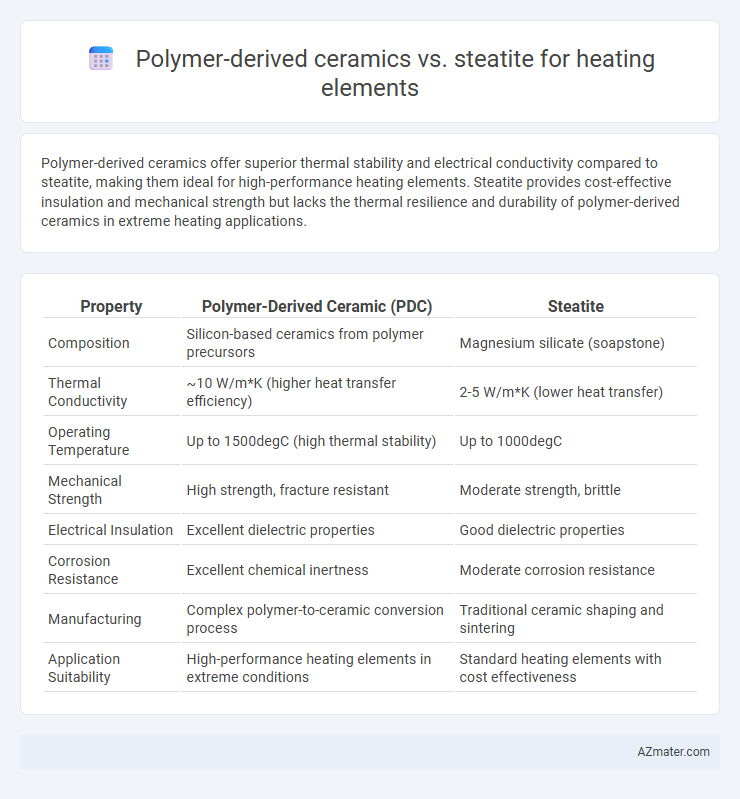Polymer-derived ceramics offer superior thermal stability and electrical conductivity compared to steatite, making them ideal for high-performance heating elements. Steatite provides cost-effective insulation and mechanical strength but lacks the thermal resilience and durability of polymer-derived ceramics in extreme heating applications.
Table of Comparison
| Property | Polymer-Derived Ceramic (PDC) | Steatite |
|---|---|---|
| Composition | Silicon-based ceramics from polymer precursors | Magnesium silicate (soapstone) |
| Thermal Conductivity | ~10 W/m*K (higher heat transfer efficiency) | 2-5 W/m*K (lower heat transfer) |
| Operating Temperature | Up to 1500degC (high thermal stability) | Up to 1000degC |
| Mechanical Strength | High strength, fracture resistant | Moderate strength, brittle |
| Electrical Insulation | Excellent dielectric properties | Good dielectric properties |
| Corrosion Resistance | Excellent chemical inertness | Moderate corrosion resistance |
| Manufacturing | Complex polymer-to-ceramic conversion process | Traditional ceramic shaping and sintering |
| Application Suitability | High-performance heating elements in extreme conditions | Standard heating elements with cost effectiveness |
Introduction to Heating Element Materials
Polymer-derived ceramics (PDCs) offer high thermal stability, chemical resistance, and precise microstructural control, making them ideal for advanced heating element applications compared to traditional steatite. Steatite, a magnesium silicate ceramic, provides good electrical insulation and thermal conductivity but lacks the high-temperature endurance and oxidation resistance found in PDCs. The emerging use of PDCs enhances heating element performance in harsh environments, enabling longer service life and improved efficiency over conventional steatite-based components.
Overview of Polymer-Derived Ceramics (PDCs)
Polymer-Derived Ceramics (PDCs) are advanced materials synthesized through the pyrolysis of preceramic polymers, resulting in ceramics with enhanced thermal stability, oxidation resistance, and mechanical strength compared to traditional materials like steatite. PDCs exhibit excellent electrical conductivity and structural uniformity, making them suitable for heating elements operating at high temperatures and in harsh environments. Their ability to be precisely shaped during the polymer phase enables complex geometries and improved performance in heating applications.
Steatite: Properties and Applications
Steatite, a magnesium silicate ceramic, exhibits excellent electrical insulation, high thermal conductivity, and superior resistance to thermal shock, making it ideal for heating element substrates. Its mechanical strength and low dielectric loss ensure durability and energy efficiency in industrial heaters, laboratory furnaces, and kiln components. Compared to polymer-derived ceramics, steatite offers cost-effective performance with consistent thermal stability in medium-to-high temperature applications.
Thermal Stability Comparison
Polymer-derived ceramics exhibit superior thermal stability compared to steatite, maintaining structural integrity at temperatures exceeding 1600degC, while steatite typically degrades around 1000degC. The enhanced thermal resistance of polymer-derived ceramics enables consistent performance under rapid temperature fluctuations and prolonged high-temperature exposure. This stability makes polymer-derived ceramics ideal for advanced heating elements requiring durability and reliability in extreme thermal environments.
Electrical Insulation Capabilities
Polymer-derived ceramics exhibit superior electrical insulation capabilities compared to steatite due to their dense, amorphous microstructure which minimizes electrical conductivity and enhances dielectric strength. Steatite, a magnesium silicate ceramic, offers good insulation but typically presents higher porosity, leading to reduced dielectric performance under high-temperature conditions. The enhanced insulation properties of polymer-derived ceramics make them highly suitable for advanced heating element applications requiring reliable electrical isolation and thermal stability.
Mechanical Strength and Durability
Polymer-derived ceramics exhibit superior mechanical strength and enhanced thermal shock resistance compared to steatite, making them highly durable for heating element applications. Steatite, while cost-effective and electrically insulating, tends to have lower fracture toughness and may degrade faster under cyclic thermal stresses. The intrinsic microstructure of polymer-derived ceramics offers improved high-temperature stability, ensuring prolonged service life and reliability in demanding heating environments.
Manufacturing Process Differences
Polymer-derived ceramics (PDCs) are produced through the pyrolysis of preceramic polymers, enabling precise control over microstructure and composition at relatively lower temperatures compared to traditional ceramic sintering used for steatite. Steatite heating elements are manufactured by pressing and sintering naturally occurring talc-rich mineral powders at high temperatures, resulting in a dense, electrically insulating ceramic. The PDC process allows for enhanced customization and integration of functional properties, whereas steatite manufacturing relies on conventional high-temperature consolidation methods yielding consistent but less flexible material characteristics.
Cost Analysis: PDCs vs Steatite
Polymer-derived ceramics (PDCs) generally incur higher initial costs than steatite due to advanced precursor materials and complex processing techniques. Steatite heating elements benefit from lower raw material prices and simpler manufacturing, leading to cost-effective scalability for large production runs. However, the superior thermal stability and durability of PDCs can reduce long-term replacement expenses, potentially offsetting higher upfront investments.
Performance in High-Temperature Environments
Polymer-derived ceramics offer superior thermal stability and resistance to oxidation at temperatures exceeding 1400degC, making them ideal for high-temperature heating elements. Steatite, while providing good electrical insulation and moderate thermal conductivity up to around 1000degC, tends to degrade and lose mechanical strength under prolonged exposure to extreme heat. The enhanced microstructural integrity and chemical inertness of polymer-derived ceramics result in longer lifespan and consistent heating performance in harsh thermal environments compared to steatite.
Future Trends and Material Innovations
Polymer-derived ceramics (PDCs) are emerging as a revolutionary material for heating elements due to their superior thermal stability, oxidation resistance, and customizable microstructure compared to traditional steatite ceramics. Future trends highlight increased research into nano-engineered PDC composites that offer enhanced mechanical strength and electrical conductivity, enabling more compact and energy-efficient heating devices. Innovations in additive manufacturing of PDCs promise precise control over complex geometries, promoting faster production and improved performance of next-generation heating elements.

Infographic: Polymer-derived ceramic vs Steatite for Heating element
 azmater.com
azmater.com